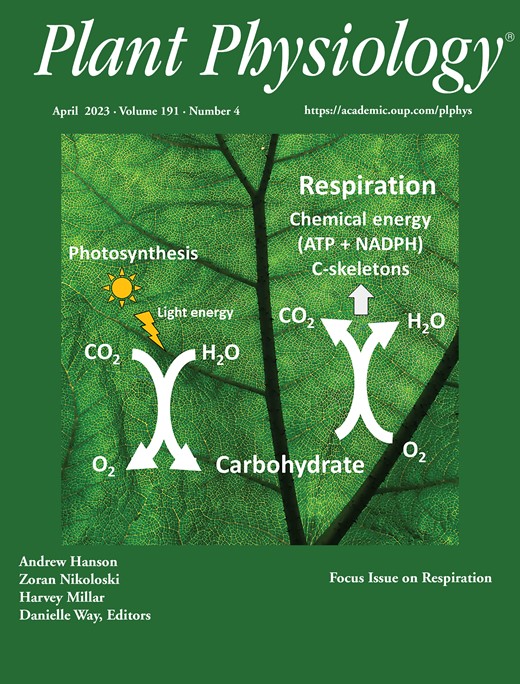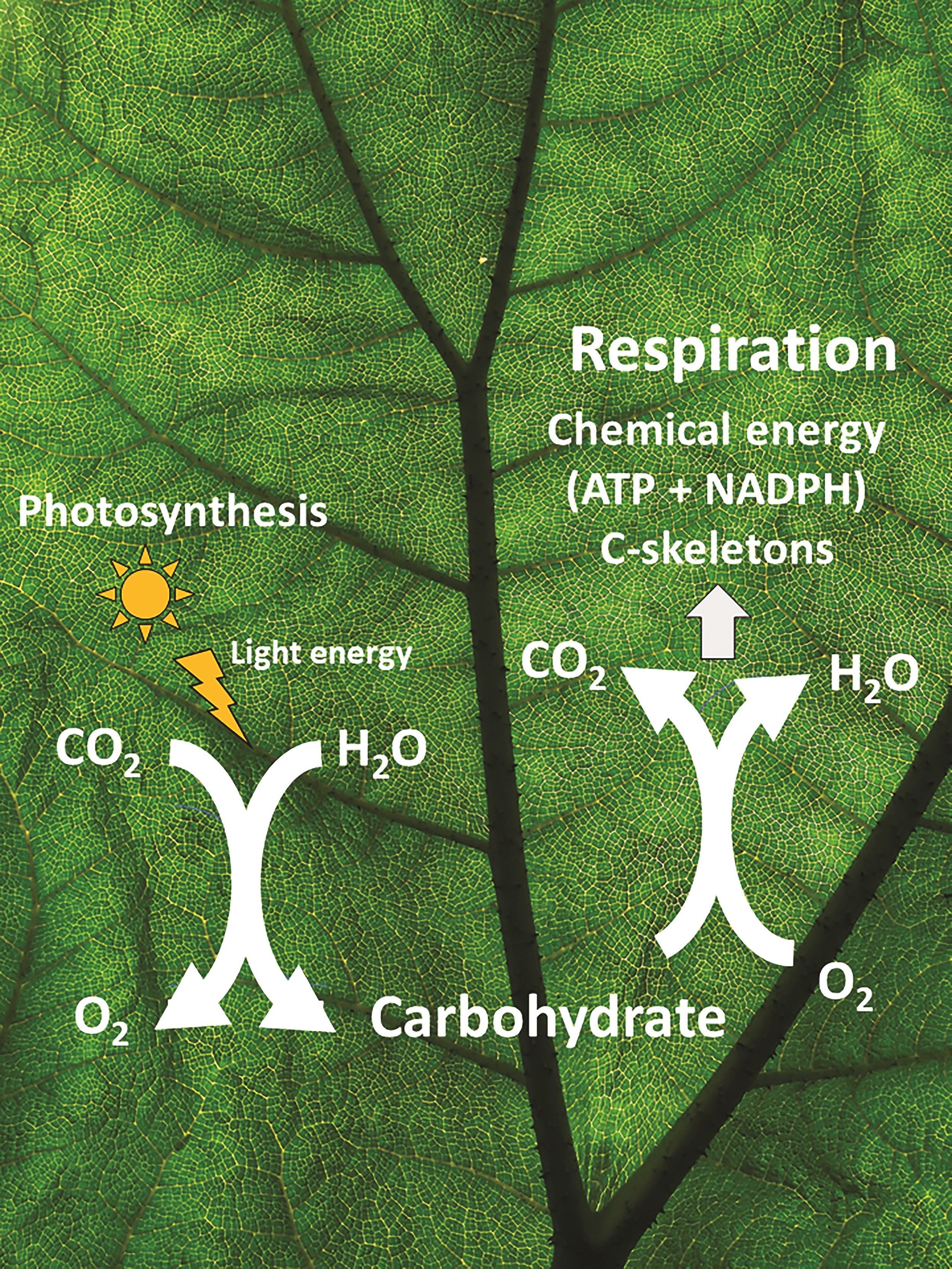
Cover image

Volume 191, Issue 4, April 2023
Focus Issue on Respiration
Editorial
Focus on respiration
Update
Breakthrough Technologies, Tools and Resources
High-throughput, dynamic, multi-dimensional: an expanding repertoire of plant respiration measurements
Membranes, Transport, and Bioenergetics
Unique opportunities for future research on the alternative oxidase of plants
Alternative oxidase has fascinated biologists for many years, and unique opportunities for research are described and highlighted for the research community to explore in the future.
Metabolism
Respiratory energy demands and scope for demand expansion and destruction
Nonphotosynthetic plant metabolic processes are powered by respiratory energy, a limited resource that metabolic engineers—like plants themselves—must manage prudently.
Mitochondria in photosynthetic cells: Coordinating redox control and energy balance
Respiration efficiently coordinates redox and energy balance in photosynthetic cells through the change of the function of a mitochondrion from the powerhouse to the thermodynamic buffering organelle.
Natural variation of respiration-related traits in plants
While most respiration-related studies accessing natural variation focus on respiratory metabolites, novel high-throughput techniques to capture respiration rates will enable novel discoveries.
The diversity of substrates for plant respiration and how to optimize their use
Plant oxidation of respiratory substrates is regulated by mitochondrial transport and metabolic processes; modifications may enable oxidation of alternative substrates and improve efficiency.
Systems and Synthetic Biology
Toward mechanistic modeling and rational engineering of plant respiration
Letters
Ecophysiology and Sustainability
Activity-dependent nocturnal decrease in leaf respiration
Nocturnal decrease in leaf respiratory CO2-release measured at constant temperature within a plant species is correlated with the level of respiratory activity at onset of the dark period.
Research Articles
Biochemistry, Biophysics, and Structural Biology
Mitochondrial ferredoxin-like is essential for forming complex I-containing supercomplexes in Arabidopsis
An atypical mitochondrial ferredoxin that does not bind an iron-sulfur cluster plays a role in the correct conformation of the membrane arm of respiratory complex I.
Defining the lipidome of Arabidopsis leaf mitochondria: Specific lipid complement and biosynthesis capacity
Ecophysiology and Sustainability
Short- and long-term responses of leaf day respiration to elevated atmospheric CO2
Combined gas exchange and chlorophyll fluorescence measurements show a reduction in leaf day respiration to elevated atmospheric CO2, greatly impacting plant carbon budgets.
Regular Issue
News and Views
Mixing it up: a chimeric tobacco-cyanobacterial photosystem II design for maximum low-light use efficiency
Double the action: multimodal action of a CONSTANS-LIKE protein enhances stress tolerance in soybean
Letters
Biochemistry, Biophysics, and Structural Biology
Transcription factor WOX11 regulates protein translation via ribosome protein acetylation in rice roots
WUSCHEL-related Homeobox 11 regulates protein translation via lysine acetylation of ribosome protein mediated by ROS in rice root meristem.
Research Articles
Biochemistry, Biophysics, and Structural Biology
Cyanobacterial photosystem II reaction center design in tobacco chloroplasts increases biomass in low light
Synechococcus low- and high-light D1 mutations confer cyanobacterial photosystem II photochemical phenotypes to tobacco plants, with low-light tobacco plants accumulating more biomass under low light.
Breakthrough Technologies, Tools and Resources
Specific suppression of long terminal repeat retrotransposon mobilization in plants
Plant tissue culture supplemented with the inhibitor of reverse transcriptase Tenofovir prevents mobilization of retrotransposons and increases the genetic stability of regenerated plants.
Cell Biology
Mitochondrial gene defects in Arabidopsis can broadly affect mitochondrial gene expression through copy number
Disruption of a single mitochondria-encoded gene causes widespread change in mitochondria and even nuclear gene expression, partially through increasing mitochondrial genome copy number.
Overexpressing Vitamin C Defective 2 reduces fertility and alters Ca2+ signals in Arabidopsis pollen
Two cyclic electron flows around photosystem I differentially participate in C4 photosynthesis
Ecophysiology and Sustainability
Melatonin-priming enhances maize seedling drought tolerance by regulating the antioxidant defense system
Melatonin-priming improves plant structure, stomatal traits, growth, and drought tolerance in maize seedlings through regulating the antioxidant deference system.
Genes and Development
HEAT SHOCK PROTEIN 90.6 interacts with carbon and nitrogen metabolism components during seed development
HEAT SHOCK PROTEIN 90.6 is involved in nutrient metabolism via 26S proteasome and GF14-4 protein in maize kernels.
Shade represses photosynthetic genes by disrupting the DNA binding of GOLDEN2-LIKE1
Shade represses photosynthetic genes by increasing the expression of a small protein that disrupts the DNA binding of a key transcription factor.
Genes, Development and Evolution
Phytochrome F mediates red light responsiveness additively with phytochromes B1 and B2 in tomato
CRISPR-induced knockout mutants suggest additive roles in red light responses for phytochrome F with phytochromes A, B1, and B2 in tomato.
Growth-regulating factor 15-mediated gene regulatory network enhances salt tolerance in poplar
Growth-regulating factor 15 in poplar acts as a multifunctional transcription factor involved in growth, development, and salt stress tolerance through a multi-level regulation network.
Transcription factors NtHD9 and NtHD12 control long glandular trichome formation via jasmonate signaling
Metabolism
Dark accumulation of downstream glycolytic intermediates initiates robust photosynthesis in cyanobacteria
Quantitative metabolome dynamics reveal that a high accumulation of glycolytic intermediates in darkness enables smooth initiation of photosynthesis in cyanobacteria.
Zeaxanthin is required for eyespot formation and phototaxis in Euglena gracilis
Zeaxanthin is required for eyespot formation and phototaxis in Euglena gracilis, highlighting the evolutionary diversity of the photosensing mechanism between euglenophytes and chlorophytes.
Signaling and Response
CONSTANS-LIKE 1a positively regulates salt and drought tolerance in soybean
The Glycine max CONSTANS-like 1a transcription factor positively regulates tolerance to salt and drought stresses by promoting the accumulation of Δ1-pyrroline-5-carboxylate synthetase.
Research Report
Signaling and Response
Sucrose-induced auxin conjugate hydrolase restores symbiosis in a Medicago cytokinin perception mutant
Both sucrose and its nonmetabolizable analog turanose restore root nodule symbiosis in a Medicago truncatula cytokinin perception mutant through induction of an auxin conjugate hydrolase.
Research Articles
Signaling and Response
The flowering time regulator FLK controls pathogen defense in Arabidopsis thaliana
A canonical flowering regulatory gene, encoding an RNA binding protein, is important for pathogen defense likely through affecting alternative splicing of target genes.
Exogenous Ca2+ promotes transcription factor phosphorylation to suppress ethylene biosynthesis in apple
A calcium module suppresses ethylene biosynthesis during apple fruit storage via regulating the phosphorylation status and degradation of transcription factor and ethylene synthase.
BASIC PENTACYSTEINE2 fine-tunes corm dormancy release in Gladiolus
BASIC PENTACYSTEINE2 fine-tunes corm dormancy release in Gladiolus by recruiting Polycomb Repressive Complex 2 and the chromatin remodeling factor EARLY BOLTING IN SHORT DAYS.
Cryptochromes suppress leaf senescence in response to blue light in Arabidopsis
Blue light photoreceptors, cryptochromes, suppress the progression of leaf senescence in response to blue light through the regulation of HY5 and PIF4/5 transcriptional factors.
U-box E3 ubiquitin ligase PUB8 attenuates abscisic acid responses during early seedling growth
Arabidopsis U-box attenuates abscisic acid responses by degrading ABSCISIC ACID-INSENSITIVE3 (ABI3) and ABI5 during early seedling growth.
Resting cytosol Ca2+ level maintained by Ca2+ pumps affects environmental responses in Arabidopsis
Basal cytosol Ca2+ levels maintained by calmodulin-regulated Ca2+ pumps have an important role in biotic and abiotic stress responses in Arabidopsis.
Organelle-targeted biosensors reveal distinct oxidative events during pattern-triggered immune responses
Systems and Synthetic Biology
Alternative 3′-untranslated regions regulate high-salt tolerance of Spartina alterniflora
Alternative 3′-untranslated regions enable post-transcriptional gene expression regulation of high-salt-tolerant genes in Spartina alterniflora.




































